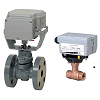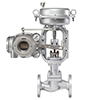Actuator
A mechanism for converting energy such as electricity, air pressure, water pressure, hydraulic pressure, magnetic force, heat, etc. into mechanical motion such as linear motion or rotational motion. Actuators are incorporated into a variety of products, including industrial equipment, home appliances, automobiles, trains, smartphones, and even medical equipment and game consoles.
- Various actuators play an active role throughout our daily lives
- With the passage of time, they have become even more precise, enabling complex operations
- The field of haptic technology is attracting attention as it enables realistic simulated experiences


Various actuators play an active role throughout our daily lives
When we perform movements necessary for daily life, such as walking, squatting, and grasping things, we use many joints in our bodies. This is not limited to humans or animals. Machine tools, cars, and other objects that support our daily lives and social activities are equipped with mechanisms like human joints, allowing them to rotate or move in a straight line. The mechanical element that plays a role similar to a human joint is an actuator. The word “actuator” originally meant something that makes something move. Today it refers to all devices that use energy such as electricity, air pressure, water pressure, or hydraulic pressure to generate mechanical motion such as linear motion, rotational motion, or spiral motion through a power source such as a motor. Devices incorporating actuators are ubiquitous in daily life, and in other words, everyday life would not be possible without actuators.
As an example, let's imagine a scene where you are going to work. The automatic ticket gate opens at the station, the train door opens and closes automatically for you to get on and off the train, the automatic door at the entrance opens at the convenience store you stop by, and what you buy is printed on your receipt. When you arrive at your company's building, the elevator tales you to your desired floor. Everything is accomplished through the movement of actuators.
Actuators are also used in water faucets, as well as in the valves that control the flow of various fluids in buildings and factories.
With the passage of time, they have become even more precise, enabling complex operations
Actuators have a long history, and it is said that a mechanism similar to automatic doors using steam was invented in ancient Greece. Furthermore, windmills and waterwheels have been widely used in production activities since the Middle Ages, and in the modern era following the Industrial Revolution and the advancement of mechanization, a wide variety of actuators, starting with steam engines and internal combustion engines, have been produced one after another to support various industries and transportation. Today, they are incorporated into a variety of products, including factory equipment, automobiles, aircraft, medical equipment, office equipment, home appliances, and smartphones.
With the recent development of digital technology, actuators are still evolving. One example is a smart actuator that is integrated with various sensors, signal processing, and control circuits. The application of digital technologies such as Internet of Things (IoT) and AI is expected to enable advanced control and complex movements, and is expected to be used in precision equipment such as robots.
Further, soft actuators are also attracting a lot of attention. Unlike power sources that use electricity, air pressure, water pressure, or hydraulic pressure, this is technology that uses the deformable nature of the material itself to move objects, and they are characterized by their small size, light weight, and flexibility. Because they can move flexibly like the muscles and joints of a living body, they are applied to artificial muscles, and are used in power assist suits and wearable robots at manufacturing, construction, and transportation sites, as well as in the medical and nursing care fields to support patient rehabilitation and independence for the elderly. Applications are also progressing in fields like the development of artificial organs such as the heart and anus.
The field of haptic technology is attracting attention as it enables realistic simulated experiences
Nowadays, when you press an icon on a smartphone display, it feels as if you are pressing a physical button, or a game console controller vibrates depending on the scene, increasing the user's sense of reality. In such a way, haptics (tactile technology) is being used widely than ever. Until now, the use of such technology was limited to user alerts, such as the vibrator used in silent mode on mobile phones, but as actuators have evolved, fine control and precise mechanical movements have become possible. This has enabled the creation of technology that not only allows you to notice, but also experience realistic movements and textures of materials. This haptics technology is expected to be used in the Metaverse*1, which has become increasingly popular in recent years, and is attracting a lot of attention as it indicates the direction of the future evolution of actuators.
Actuators are everywhere and make our lives more convenient. If you pay close attention, you will notice that they are used in many things. Actuators are expected to play an increasingly important role in the future as a response to social issues such as the declining workforce and the promotion of digital transformation (DX)*2.

*1 Metaverse
A virtual space built on the Internet in which avatars (characters that act as your alter egos) allow you to interact with the real world.
*2 Digital transformation (DX)
Changing people’s lives for the better by spreading advanced digital technology throughout society.


